#Chinese civilisation
Explore tagged Tumblr posts
Text
sometimes i forget my experiences are not universal because what do you mean no one outside my specific combination of country + age group knows about the absolutes insanity that surrounded 马小跳 in 2021
#fresh off pandemic 13 year olds were making thirst edits and writing smut about a character in a chinese textbook#talking to myself#i hope when the apocalypse comes 马小跳 is the only evidence aliens have of human civilisation
0 notes
Text
Open Letter to Saviour of the Trinity Cross Key Keeper of City Guardian of Demokrissy
The More Things Change: From Montage of Articles & Columns on Social and Economic Development (c) KrisRampersadArchives2016 Dear Father Tony, Please hear my plea, To revive the economy Try that city key Tho of you and me Dey making bobolee And the poor already Heading to vagrancy Save this country We call La Trinity I may call you that, Dear Father Tony, may I not, although we is not family,…

View On WordPress
#Best of Books#Blogger#book#Books#Caribbean#Caribbean archeology#Carnival#Chaguaramas Development Authority#change#Child#Chinese#chutney#CiTTyscapes#city#civilisation#Climate Change#colonial#colonialism#Colonialism#Commission#Commonwealth Foundation#community#conservation#Constitution#Convention#corruption#country#creative industry#crime#criminal
0 notes
Text
Venusians: The Cult of Exclusivity
In my research, I have stumbled upon Venusians either being drawn into cults or being cult leaders. It did not surprise me particularly. All Venusian nakshatras (Bharani, Purvaphalguni, Purvashada) are ugra nakshatras known for being "violent". Venus is in itself, a harsh planet. In fact, all the benefic planets (Jupiter, Venus, Mercury & Moon- in that order) are harsh and for good reason; its natives have to be "purified" by the working of those planetary energies to earn its blessings. Venus values exclusivity and separatism. There is a reason why Venus attracts Venus. It is a kind of elitism. We talk about how rare beauty and glamour is these days and we fawn over the nonchalance and effortless cool of low key & mysterious celebrities. If someone or something is plastered everywhere, it loses its "special" feeling, Venus does not mingle with the masses, Venus sets the standard, its THE blue print but it does not involve itself with anything directly, they like to sit back and watch others ape them.
All 3 Venus nakshatras have yoni animals that point to a highly sexual nature and high libido. Bharani with its elephant yoni signals an immense sexual appetite (elephant being the largest land animal and yoni animal), Purvaphalguni and its rat yoni points to freaky deaky sexual behaviour and Purvashada and monkey yoni ,,, well,, monkeys are known for their lovemaking and how human like it is so..
Sex is a big focus of all 3 Venus nakshatras, with Bharani's themes of birth and death and its symbol literally being the yoni, Purvaphalguni representing the pleasures of the bed and being symbolised by the front legs of the cot and Purvashada with its connection to water, where life originated. Venus is more than just beauty and beauty itself is more profound than "looking good". Venus is beauty, romance, love, creativity, harmony, values etc.
I have talked about Venusian men and their tendency to be drawn to violence before. If we think of sex, it is a kind of violent act in itself, there has to be a back and forth of domination and submission. If we look at animals, male animals often kill other males to eliminate competition and establish themselves as the alpha that the females pick but even in coitus with female animals (literally watch any nature documentary) the male takes on a very aggressive, dominant approach and they often look like theyre trying to kill each other (people say things like "making love like animals" for a reason, sexual courtesy is a humane, civilised approach but animals are not wired that way). In Venusian men, this kind of aggressive erotic sexual persona is very apparent and Claire said these men embody "big dick energy".
Occult knowledge is gatekept and one literally cannot access it until one is initiated into it. Regardless of whether or not we recognise it as such, there are cults of knowledge all around us and we do not even know of their existence unless we've made it past their barrier and can access it. even explaining things defeats the purpose because only someone who's ready to understand it will be able to. Its nature's way of shielding itself from the unwise or the unworthy. you can be surrounded by this knowledge and still not be able to tap into it, if you do not have the discernment. this is a kind of Venusian exclusivity.
If you think about it beauty is pain. These days we see people literally endure pain to be beautiful via cosmetic procedures but this has always been the case, victorian women used arsenic to keep their skin pale and glowy and ammonia in their hair. footbinding was a common custom for Chinese women. but even beyond enduring pain to be beautiful, if you're beautiful you will have to endure pain, be it in the way others hurt you and ostracize you out of jealousy or in how people just assume crazy shit about you. Venusian women NEED to remain lowkey bc they're more susceptible to evil eye.
(im thinking of the song pretty hurts by purvaphalguni sun beyonce 👀)
anywaaayys (me going on a random tangent exhibit 62772). we know that Venusians value and need exclusivity, they're the most clique-y in some ways and this is what makes them drawn to cults lol. A cult is as exclusive as it gets. nothing screams "im not like the others" than being a part of a cult lol
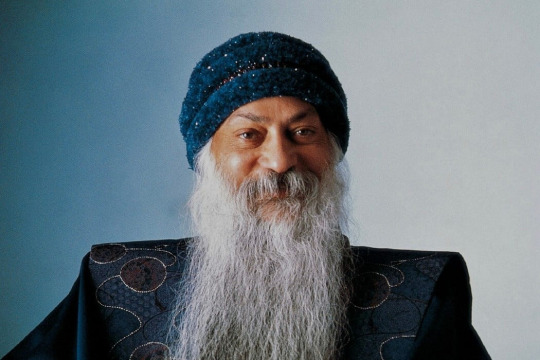
Osho- Purvashada Stellium (moon, mercury and venus)
Osho was an Indian spiritual guru and mystic. His commune and the crazy shit that went on there was the subject of the docu-series Wild Wild Country.
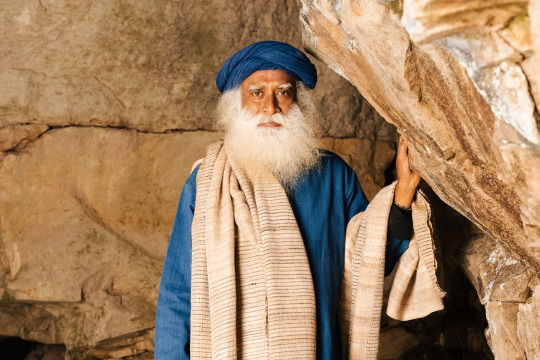
Sadhguru- Purvaphalguni Sun
he is an indian guru. i think its interesting how cults have to have a physical existence by way of a commune that people gather in or live in, its not just conceptual if ykwim. i think this is another manifestation of Venusian exclusivity. entering into a cult means entering and inhabiting a different world. Osho had Rajneeshpuram, Sadhguru has his Isha Centre.
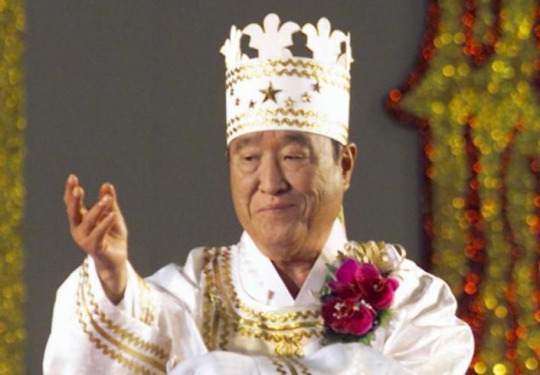
Sun Myung Moon- Bharani Moon
He was the leader of the Unification Church, a famous South Korean cult and he claimed to be the Messiah
Moon was intent on replacing worldwide forms of Christianity with his new unified vision of it, Moon being a self-declared messiah. Moon's followers regard him as a separate person from Jesus but with a mission to basically continue and complete Jesus's work in a new way, according to the Principle.
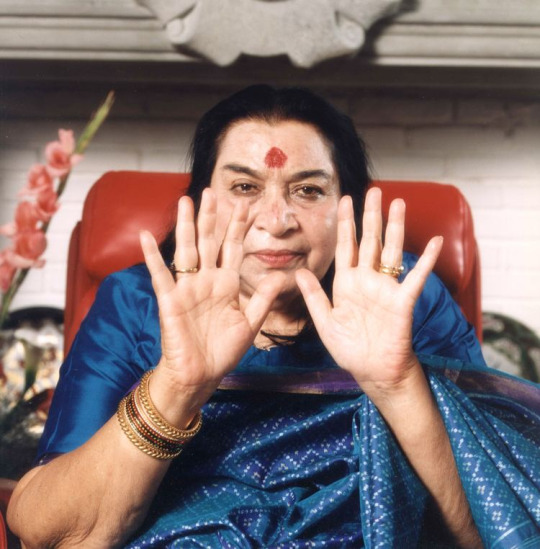
Nirmala Srivastava- Bharani Moon conjunct Mars
aka Mataji Nirmala Devi, she was the founder of the religion called Sahaja Yoga. She claimed that she was a divine incarnation, more precisely an incarnation of the Holy Spirit, or the Adi Shakti of the Hindu tradition, the great mother goddess who had come to save humanity. This is also how she is regarded by most of her devotees. she has said that she was born "self realised" and spent her life "helping" others do the same
The Venusian urge to start a new religion 😤😤😤lol
Religion is exclusive and if you do not have the discipline to endure its rules, you cannot gain access to its blessings. Religion esp eastern religion is extremely Venusian af, there are wonderful blessings for those who devote themselves to it and cruel sickening punishments for those who disobey. thats as Venusian as it gets

Anandamayi Ma- Bharani Sun, exalted Venus in Revati as her atmakaraka
She was an Indian saint, teacher, and mystic. She was revered as an incarnation of Hindu goddess Durga.
Her life was suffused in Bhakti Yoga and she was considered an epitome of "divine grace" that inspired the societal cultural milieu to lead the path of service, love and constant remembrance of the divine. Her followers experienced her spiritual attributes including precognition, faith healing and miracles. Paramahansa Yogananda translates the Sanskrit epithet Anandamayi as "Joy-permeated" in English. This name was given to her by her devotees in the 1920s to describe her perpetual state of divine joy.
she wasn't a cult leader or anything, just a guru even though she rejected even that label (spiritual gurus are a dime a dozen in india, no one who's actually worth their salt will label themselves as a guru)
i think Venus' connection to religion, cults and the occult is underexplored af. the highest form of love is devotion and religion/cults demand it of their followers making it a very Venusian experience. sex, love and religion are all closely connected, people experience trance like states when they're orgasmic or during periods of intense meditation (it can also be artificially induced via drugs etc but euphoria is naturally experienced through either prayer or sex) if you look at paintings of Hindu gods and goddesses, their eyes always seem so blissed out? same goes for truly spiritual people, you can immediately sense the tranquillity of their energy and the dreaminess of their gaze, like they're not of this world.
even the word "Ananda" which means joyous, etymologically means "without end" (Ah- meaning "without in Sanskrit and nand- meaning end) so the goal of any spiritual pursuit is self realization/actualisation and a person who achieves that seems joyous all the time. Many spiritual gurus have Ananda as part of their name as well.
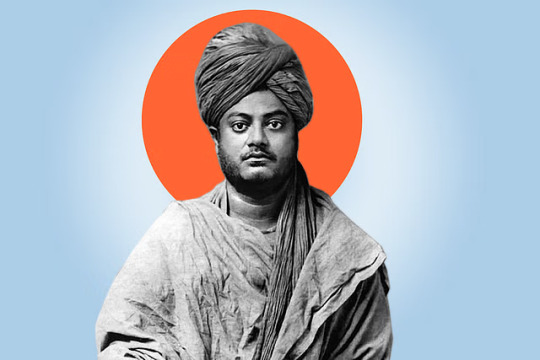
Swami Vivekananda- Purvashada Rising
He was a monk, philosopher and religious teacher who is widely credited with introducing Hinduism to the West.
“All love is expansion, all selfishness is contraction. Love is therefore the only law of life. He who loves lives, he who is selfish is dying. Therefore love for love's sake, because it is the only law of life, just as you breathe to live."- Swami Vivekananda

Paramhansa Yogananda- Purvashada Sun
Paramahansa Yogananda was an Indian-American Hindu monk, yogi and guru who introduced millions to meditation and Kriya Yoga through his organization, Self-Realization Fellowship / Yogoda Satsanga Society of India.
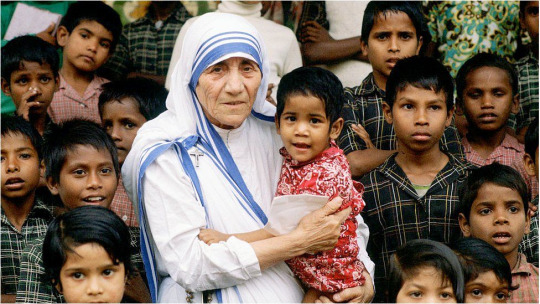
Mother Theresa- Bharani Moon & Saturn, Mars in Purvaphalguni
Mother Theresa was an Albanian nun who came to India and helped the poor and the needy. She established charitable settlements that have come under fire for mismanagement and misappropriation of funds.
Now I'll talk about some people who've gained a cult-like following or were revered in their time and considered akin to God.

Eva Peron- Bharani Sun
Known by her nickname Evita, she was an Argentine politician, activist, actress, and philanthropist who served as First Lady of Argentina from June 1946 until her death in July 1952. She was revered by the lower economic classes and helped enact a number of reforms and policies to their benefit. She also helped bring about the passage of Argentina's women's suffrage law. even decades after her passing, the grip she has on people in Argentina is crazyyy.
fun fact: Madonna, Purvaphalguni Moon & Rising played Evita in the movie of the same name in 1996.
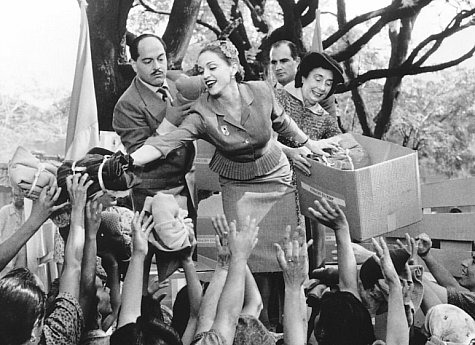
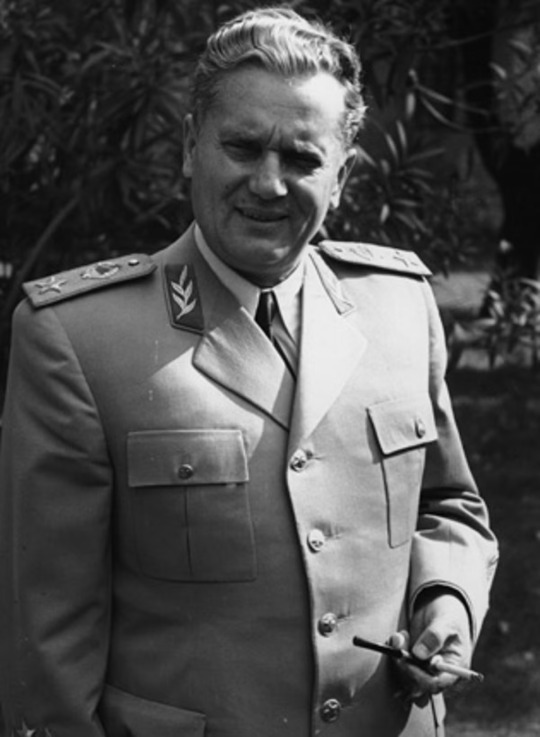
Tito- Bharani Sun
Josip Broz, commonly known as Tito, was a Yugoslav communist revolutionary and politician who served in various positions of national leadership from 1943 until his death in 1980
He was a popular public figure both in Yugoslavia and abroad. He remains a popular leader in the former countries of Yugoslavia. Tito was viewed as a unifying symbol, with his internal policies maintaining the peaceful coexistence of the nations of the Yugoslav federation. his legacy lives on and he was a VVV popular
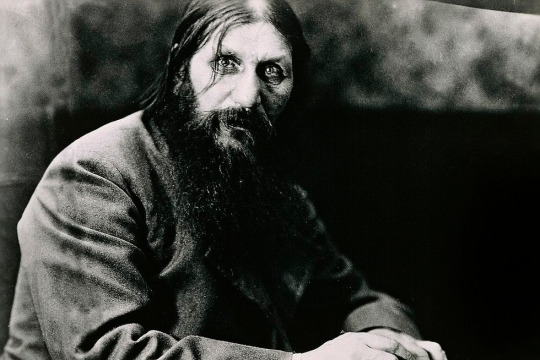
Rasputin- Bharani Moon
He was a quack with no actual powers but man did he have a following
Rasputin was a Russian mystic and holy man. He is best known for having befriended the imperial family of Nicholas II, the last Emperor of Russia, through whom he gained considerable influence in the final years of the Russian Empire
Historians often suggest that Rasputin's scandalous and sinister reputation helped discredit the Tsarist government, thus precipitating the overthrow of the House of Romanov shortly after his assassination.
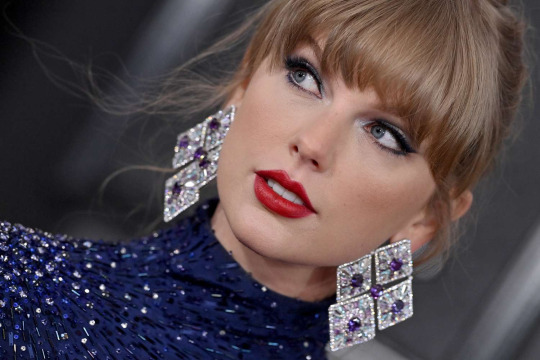
Taylor Swift- Purvashada Rising
Taylor's chokehold over her fandom is insane. I think it's due to her PA Rising bc wheww
There is a reason why Venusian influence is sooo common in the charts of it girls and icons. Venus is THE blue print, it makes others want to be like you and imitate you and also claim they hate you or dont know you all in the same breath.

Trisha Paytas-Bharani Sun & Jupiter, Ketu in Purvaphalguni
Trisha has a cult like following whether u want to admit it or not. Girlie has been doing this for a decade and a half and is still somehow relevant?? literally most of her contemporaries have been cancelled or left the platform and she's still standing?? despite a gazillion controversies that too lol
Now I'll mention some famous celebrities who are in/have been in cults

John Travolta- Purvaphalguni Moon
He was/is a Scientologist
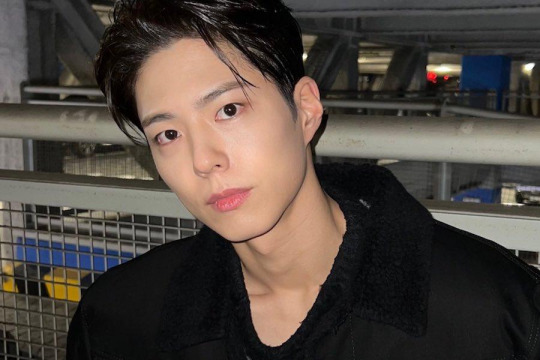
Park Bogum- Bharani Moon & Venus
Bogum is part of Jesus Centred Church which is a cult and he was apparently even given his name by the founder/leader of the cult. There have been rumours that Bogum left the controversial church/cult and joined a normal church but there isnt enough info to confirm this

Nazanin Boniadi- Purvaphalguni Moon
She is a former Scientologist who was "trained" to be Tom Cruise's gf before he met Katie Holmes. read about the crazy and torturous stuff she was subjected to and you'll wonder why tf scientology hasn't been shut down by the government yet
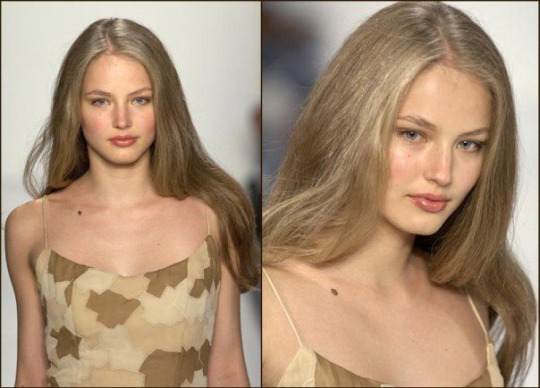
Ruslana Korushnova- Purvaphalguni Moon
She was found dead at 20yrs old under mysterious circumstances. i do not think she committed suicide at all but she spent some time at the Rose of the World which is a culty organisation.
British TV producer and filmmaker Peter Pomerantsev has theorised that Korshunova's suicide was related to her involvement with Rose of the World, a controversial Moscow-based organisation which describes itself as "training for personality development". While researching for a documentary into Korshunova's death, Pomerantsev learned that the model spent three months attending training sessions at Rose of the World. These sessions—which encourage participants to share their worst experiences and recall repressed memories—are modelled after Lifespring, whose controversial methods were the subject of multiple lawsuits for mental damages in the US during the 1980s. Korshunova attended training sessions with a friend, Ukrainian model Anastasia Drozdova, who committed suicide under similar circumstances in 2009. Friends of the two women reported changes in behaviour after several months at the Rose. Korshunova became aggressive, while Drozdova experienced violent mood swings and grew reclusive; both lost weight. After three months of training, Korshunova returned to New York to look for work, where she wrote of feeling lost and doubting herself. Rick Alan Ross, head of the Cult Education Forum, argues that organisations such as Rose of the World "work like drugs: giving you peak experiences, their adherents always coming back for more. The serious problems start when people leave. The trainings have become their lives—they come back to emptiness. The sensitive ones break." Only months after leaving the Rose, Korshunova was found dead.

Michelle Pfeiffer- Bharani Sun, Purvaphalguni Moon, Rohini Rising
She was involved with Breatharianism, a cult that believes that you don’t need to eat food (Say what?!). She joined after moving to Los Angeles and looking for a group to feel comfortable with. They focused on diet and exercise but believed that people could live by sunlight alone at the highest level of the cult. She actually realized that she was in a cult after helping her first husband Peter Horton prepare for a movie role where he played a cult member. She said, “We were talking with an ex-Moonie, and he was describing the psychological manipulation and I just clicked.” (crazy to me that the not eating real food did not click??)
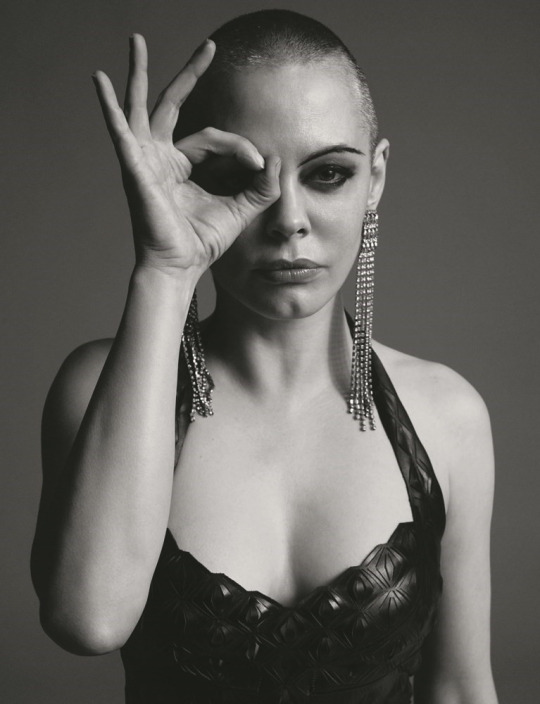
Rose McGowan- Purvaphalguni Sun & Mercury, Mars in Bharani
She spent her childhood in the Children of God cult and her family fled from its clutches after they started advocating for adult-child sexual intercourse🤮🤮🤮
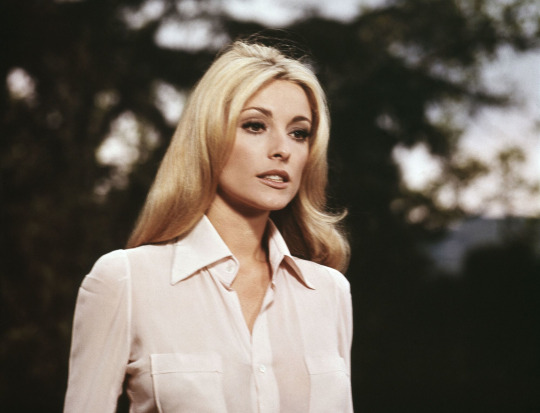
Sharon Tate- Purvaphalguni Moon
Sharon wasn't a member of a cult but a victim of one :((((
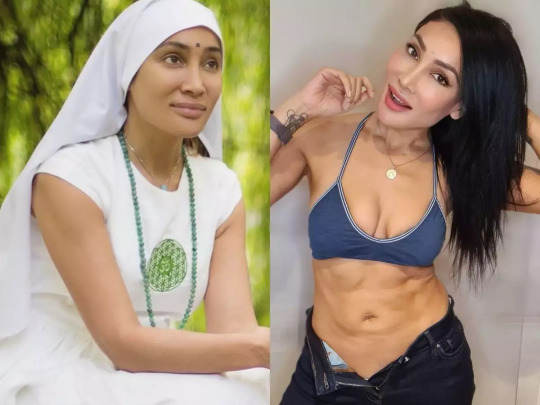
Sofia Hayat- Purvaphalguni Moon
Sofia was a model, then she quit the industry to be a nun, now she calls herself a shaman and a healer and posts weirdly sexual vids on IG
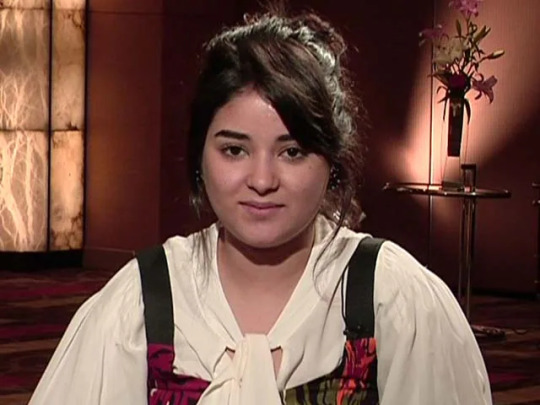
Zaira Wasim- Purvaphalguni Moon
she quit acting to devote herself to religion and because she felt that being in Bollywood made her lose touch with her faith.
This is a very Venusian experience imo and one of the reasons why Venus thrives in keeping itself hidden or taking away other people's access to it is because otherwise Venusians feel contaminated almost?? other project onto them heavily and they feel clouded by it, unsure of their own identities. they feel like they're losing touch with themselves. many Venusian celebs are known for frequently changing their persona (Bella Hadid, Ariana Grande etc come to mind) the more time they spend exposing themselves to others, the more confused they become about who they are, they lack a stable self image.
Religion and faith can act as stabilisers and help these natives feel more grounded.
A reason why Venusians (idk if you noticed by most of the gurus were Purvashadas and most of the followers I mentioned were Purvaphalgunis, with an equal mix of Bharani natives in both) are drawn into cults is also because Venusians can only thrive in Venusian environments?? Otherwise they feel desolate and lost, a lot of people join cults because they don't feel understood or connected to people in their normal life. cults look for people who need help, and give it to them on predatory conditions.
Purvashadas are often spiritual leaders/gurus but seldom blindly devoted followers because being the final Venus nak, it transcends this toxic grip of Venus. Purvaphalguni is the height of Venus and these natives are constantly seeking spiritual truth and belonging but never quite ascending, as it is Venus at its most indulgent. Bharani is the first Venusian nak and I have found that the first nak of any planetary dominance is in some ways its "softest" manifestation, its the baby among the naks. The nak in the middle is the peak/height of that planetary energy and thus, the most cruel or harsh manifestation of that energy along with the concluding nak but the concluding nak also kind of transcends its influence??
high fashion/luxury etc is also very Venusian bc theyre the ones who covet having things others dont have. anywayyys this is just a stray thought lol
hope this was informative!!
#venus#bharani#purvaphalguni#purva ashadha#astrology notes#sidereal astrology#vedic astro notes#astrology observations#astrology#astroblr#nakshatras#vedic astrology#astro observations#astro notes
498 notes
·
View notes
Text
But the policy of the tsarist government in China is not only a mockery of the interests of the people—its aim is to corrupt the political consciousness of the masses. Governments that maintain themselves in power only by means of the bayonet, that have constantly to restrain or suppress the indignation of the people, have long realised the truism that popular discontent can never be removed and that it is necessary to divert the discontent from the government to some other object. For example, hostility is being stirred up against the Jews; the gutter press carries on Jew-baiting campaigns, as if the Jewish workers do not suffer in exactly the same way as the Russian workers from the oppression of capital and the police government. At the present time, the press is conducting a campaign against the Chinese; it is howling about the savage yellow race and its hostility towards civilisation, about Russia’s tasks of enlightenment, about the enthusiasm with which the Russian soldiers go into battle, etc., etc. Journalists who crawl on their bellies before the government and the money-bags are straining every nerve to rouse the hatred of the people against China. But the Chinese people have at no time and in no way oppressed the Russian people.
V. I. Lenin, The War in China, December 1900
Two points: first, Lenin's earlier writing is particularly interesting because you can follow the trajectory of his political evolution, as dictated by changing conditions and unfolding events; second, this was published over a century ago - the fear-mongering journalists are alive and well
321 notes
·
View notes
Text
the problem with natlan / sumeru
warning: long post
──────────────────
to preface this i’d like to say that i’m in no ways an expert in the topics present, i’m just an autistic dumbass with too much time on his hands who enjoys a bit of research — i’m in no way, shape or form trying to belittle players who are excited for the update, by all means i hope you enjoy it, i’m just trying to give criticism.
you can enjoy/play a game while criticising it simultaneously.
when it comes to the topic of racial diversity and a company like hoyoverse that’s based in china, there’s quite a lot of political baggage that comes along with it. while i’ll try my best to go over that, i’m afraid i can only give a very limited eastern european perspective on it and i’ll certainly get things wrong or misinterpret things — if you’d like a more thorough view on the politics, please go read the post made by @zeichannnnn (hope you don’t mind the tag my love)
firstly, i’ll be going over general misconceptions, ridiculous excuses and or stereotypes that i’ve seen commonly come up in this conversation.
any and all screenshots will have usernames cut off for privacy, i want to maintain a civilised discussion and not cause argument.
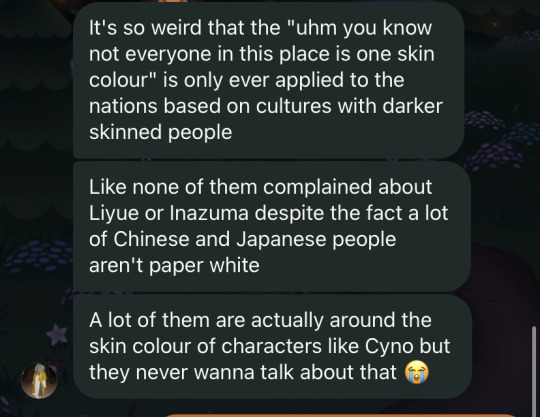
a lot of my critiques are more so towards the attitude the fandom has when it comes to this argument and their blatant colourism. as my friend above says, no one ever complained about characters in liyue/inazuma being paper white despite the fact realistically, no one in EA is that colour naturally. this of course stems from the beauty standards but that’s a discussion for later on.
the point is that if say a nation like liyue, had the same skin colour as a character like xinyan (who hails from liyue and has a liyue name) people would undoubtedly be upset. so why is it that when in terms of nations that are based off countries with a darker skin colour variety, complaining about the characters being white is seen as a problem?
culture isn’t defined by racial diversity, but when you’re monetising off the representation of different countries cultures, the very least you can do is show the actual diversity within said culture instead of slapping a cultural name on a white model (cue that one picture of the egyptian dude who looks like a plain american).
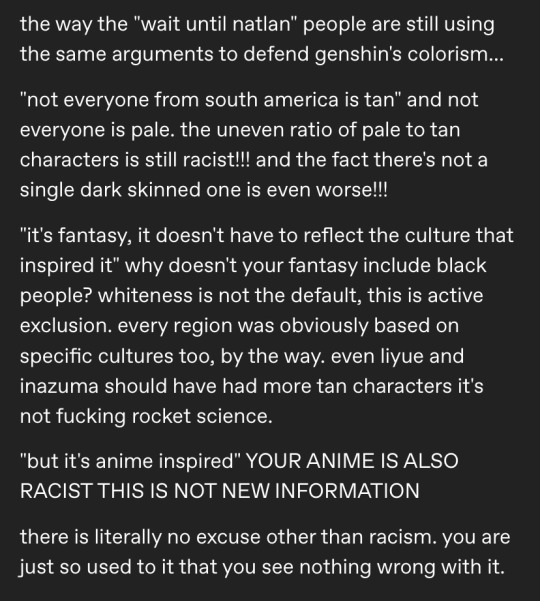
the idea that because it’s fantasy or anime, having black characters is surreal or improbable is rooted in white supremacy’s hold over unfair beauty standards as well as just the general consensus that black people are less desirable in media. which is completely false.
characters like dehya have proven that a character’s race is irrelevant when it comes to likeness, given the fact the chinese community ended up donating to charities because of said characters story.
the reason why the lightly toasted characters appear tan to you is because the rest of the cast is so horrifically pale (nahida’s hex code is #FFF7F1, cyno’s is #EEC6A6 which when placed next to each other may look like a big difference, but in reality the colours are on the same side of the colour wheel only a few spaces apart).

hoyoverse does in fact use culture as a mere aesthetic and costume to plant on white models. that is NOT to say they misrepresent culture entirely: this post goes over how hoyoverse is perfectly capable of doing impressive research to bring forth forgotten or unknown bits of culture.
even aside from the problems with racial diversity, the character design department has been known to completely fail when it comes to accurate representation. from the sexualisation of the kimono in characters like raiden shogun (which even the eastern part of the fandom have been upset about) to the character of yunjin where the chinese player based believed she was more like a lolita inspired caricature than a real depiction. they don’t understand how to mingle tradition with modernism.
in all fairness, it is difficult — and i will praise the game for making natlan much more technologically advanced and vibrant than people were expecting because having the one nation that’s based off africa and indigenous people be a wasteland would’ve ultimately been a problem. personally, i even love the slight mashup of “tribes” and the pokémon esque aesthetic — its new, and a smart way to bring two things together.
same thing cannot be said for how hyv ignores the fact darker people of colour are also significant when it comes to the building of culture.
please read over these that go more into depth about problems:
natlan being an amalgamation of three separate countries/cultures.
misrepresenting both continents natlan’s based from
another thing that’s always bothered me is the excuses people used in sumeru about the presentation of characters that were based off real people; specifically, kusanali.
yes, she’s based off a hindu moon goddess who’s described as pale and sure that could’ve been the reason she’s nearly the colour white — but how come candace, who’s based off kandake, a fully black woman, is presented as being slightly tan? you can’t pick and choose what you represent and honestly the idea that nahida’s character is supposed to be a depiction of the moon goddess is disrespect to the goddess herself (please go look at a singular picture of her and you’ll understand the utter tragedy).
hoyoverse also has a bit of a history with both whitewashing their slightly tan characters (nekomiya from zoneless zen zero, arlan from honkai star rail etc) but i think one of their biggest proofs of disrespect comes to carole pepper from hi3.
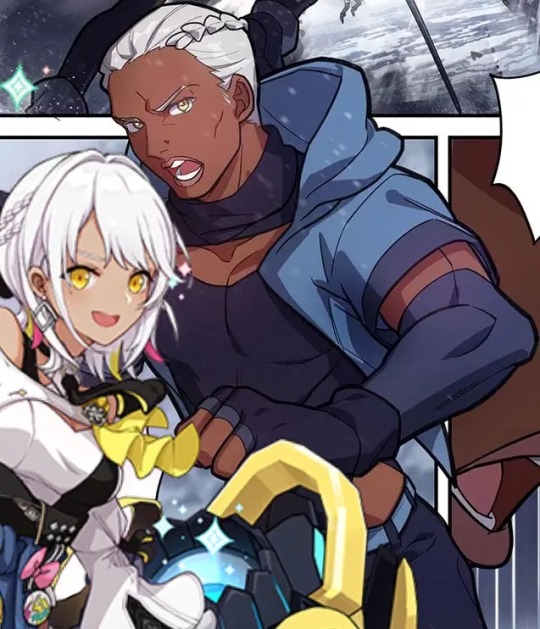
now, this is not at all me saying you can’t present female characters as very muscular — no. in fact, i would’ve loved if characters like beidou had a similar sort of build. but out of all the characters you could’ve chosen to give this to, you chose a black woman.
would this be a problem if it continued with other characters? not really. the issue lies within the fact the ONLY mother in game who’s presented as buff and “masculine looking” is a black woman — something that’s quite literally a stereotype against black women who are regarded as “naturally less feminine” than white women.
eastern beauty standards
the assertion that eastern beauty standards prevent the inclusion of black characters in video games is not only invalid but also reflects deeper issues of bias and systemic exclusion in the gaming industry. this argument is flawed for several reasons, including the diversity of beauty standards in eastern cultures, the global nature of the gaming market, and the responsibility of creators to reflect and promote inclusivity.
to claim that eastern beauty standards universally exclude black characters oversimplifies and homogenizes the diverse beauty ideals present in countries like japan, south korea, and china. these cultures are not monolithic and have their own histories and contemporary movements that embrace a variety of appearances.
creators in the gaming industry have a responsibility to reflect the diversity of the real world and promote inclusivity. video games are a powerful medium that can shape perceptions, challenge stereotypes, and foster empathy. by including black characters, game developers can contribute to a more inclusive and equitable society. this requires intentionality and a commitment to representation that goes beyond mere tokenism. the argument that eastern beauty standards prevent such inclusion suggests a lack of willingness to challenge existing norms and expand the narrative possibilities within games. hoyoverse have themselves stated in their mission statement that their goal is to show inclusivity.
that’s not to say it’s not clear that china’s beauty standards have unfortunately affected the gaming market: but for a game that brandishes itself on localising itself for a global audience (meaning, outside of its region), it’s a poor excuse. those standards aren’t universal and shouldn’t be used as gateway into designing.
once again, i am NOT at all very well versed in politics especially one that’s overseas (well, next door neighbour in a way) so i definitely will misinterpret or misunderstand things unintentionally and if i do, i’m really sorry.
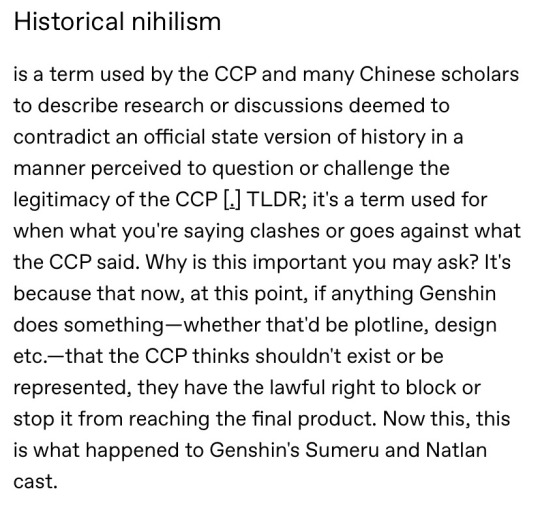
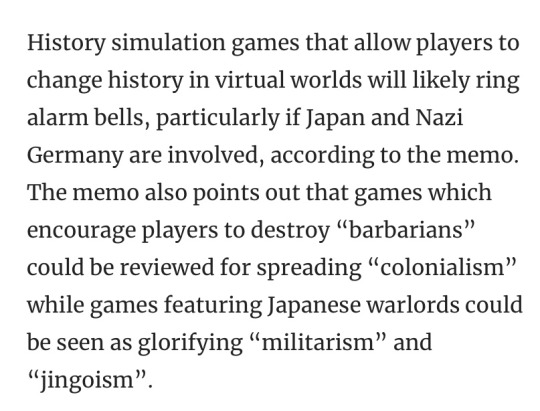
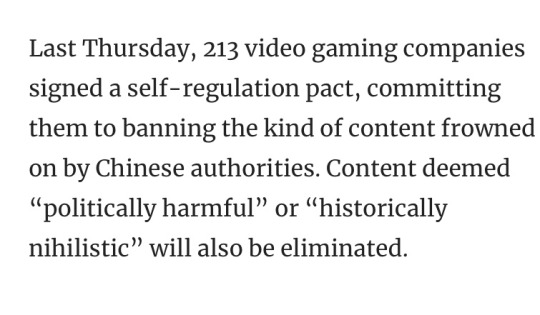
historical nihilism to me doesn’t relate to black people, just actual story events (hence why hoyoverse had to put a warning label for fontaine that the events presented didn’t represent that of the real world and any similarities were mere coincidence). black people existing isn’t regarded as “politically harmful” neither is it an extraordinary idea — it’s just another group of people.
although, the CCP has a MASSIVE history about their demonisation and hatred of black people therefore, even without the idea that the censorship stems from something like historical nihilism, it’s likely something to do with individual prejudice.
politically, i can semi-understand why hoyoverse is in a tight space for racial diversity. but that doesn’t mean i’m willing to baby a company that profits billions worth of profit from other cultures that they misrepresent and i’m even less inclined to hold the hands of hoyoverse dickriders who believe people complain about race just solely to whine. it’s a real systemic issue, and one that’s prevalent in a multitude of games aside from genshin.
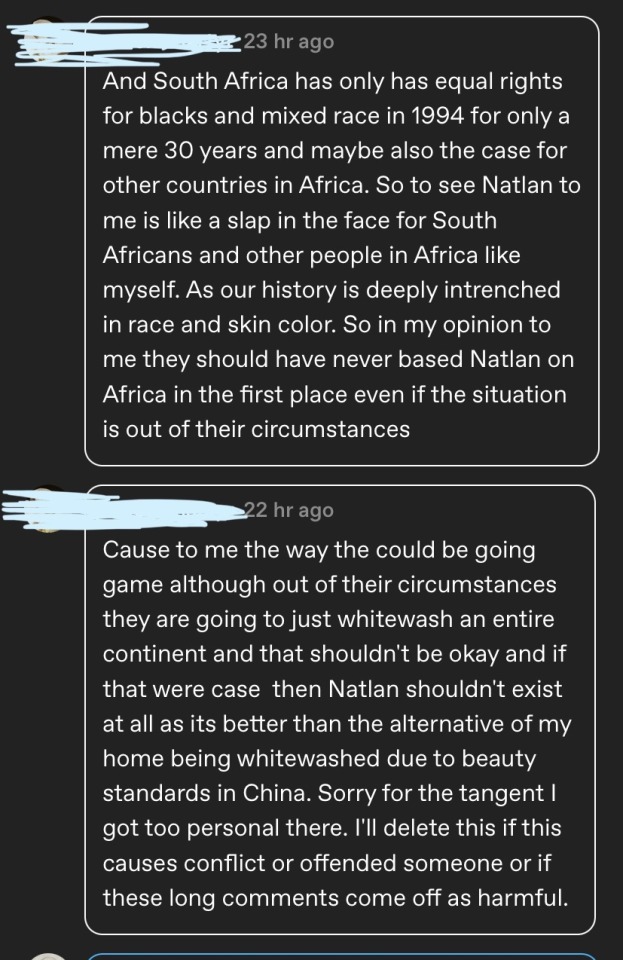
people from the cultures presented are rightfully upset and they shouldn’t be told to just “accept”mediocrity. it’s their culture and identities being ridiculed, it’s their identities being profited from for the sake of aesthetics for a game that preaches inclusivity to the people that are willing to ignore its prejudice.
hell, even as a polish person, just thinking about what they’ll do with snezhnaya upsets me even if it’s not racially based — once again, the media emphasises the idea that eastern europe / slavic culture is purely russia meanwhile they steal little things from all of the surrounding countries in eastern europe (won’t forget the fact they changed that password thing in sumeru from “ravioli” to “pierogi”).
──────────────────
TL;DR hoyoverse uses other people’s cultures and identities as an aesthetic and proceeds to profit off of it while misrepresenting the sample of people they chose to depict and while a political argument can be made in this regard, ultimately the backlash from people rightfully feeling unjustified in the lack of racial diversity is what amplifies these colourist attitudes: and while hoyoverse has seemingly much more legal repercussions to commit to their idea of diversity, the fandom has no excuse for their disregard of different identities.
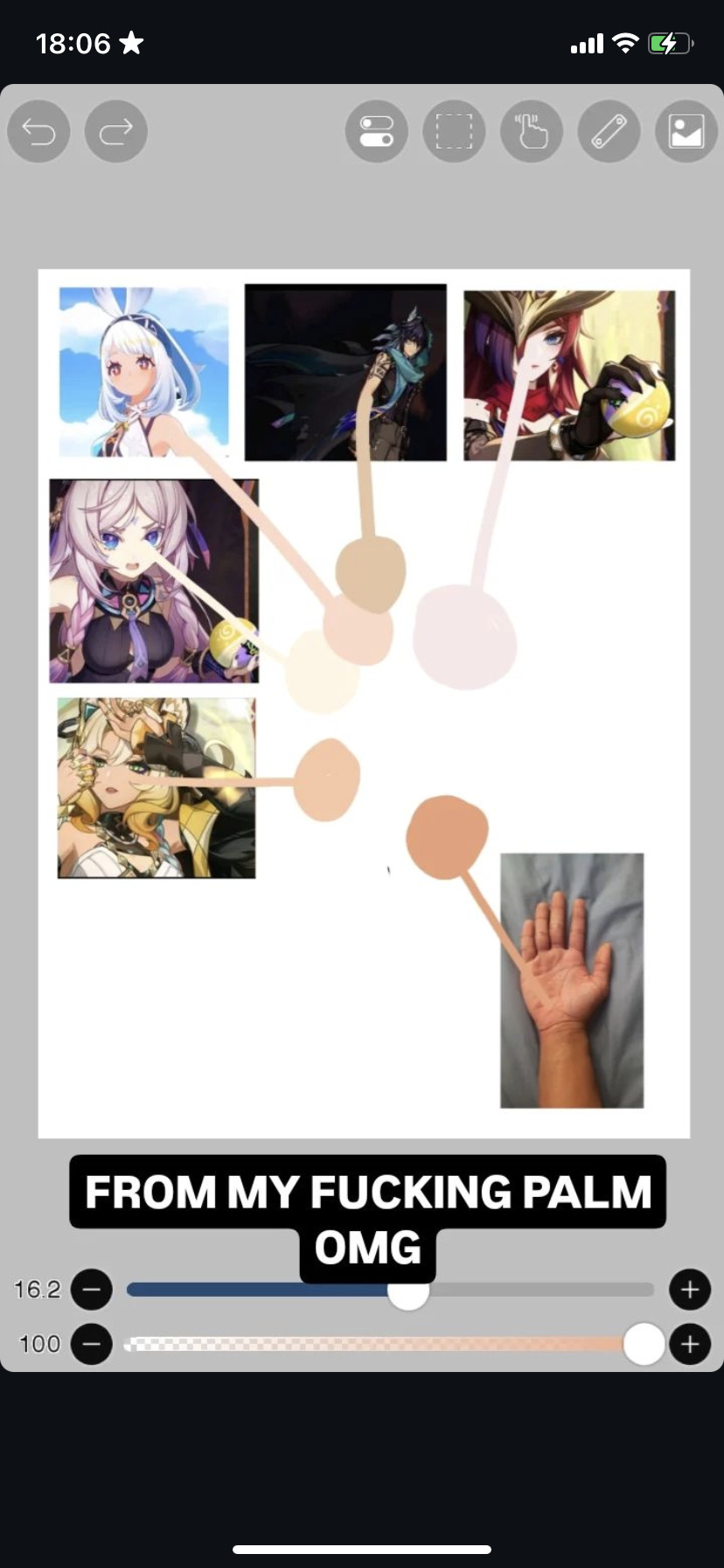

also just a funny thing my friend and i did to show just how white these characters are lol
“ blackwashing “ versus “ whitewashing “
i feel like i need to add this little section too because i know there will be a lot of people that draw or reimagine the characters in a variety of different skin tones, and i know a lot of people will be upset (usually it’s just the lowlife weebs who cry at the thought of a black woman being in the same room as them).
historically, media, including video games and anime, have predominantly featured pale-skinned characters, often neglecting the representation of people of color. this lack of diversity reinforces a narrow view of beauty and heroism, contributing to the systemic exclusion of non-white individuals. blackwashing helps to rectify these historical imbalances by providing a broader spectrum of racial representation. it challenges the default assumption that characters must be pale-skinned and introduces audiences to a more inclusive range of appearances.
representation matters profoundly in media. seeing characters that reflect one's own identity can have significant positive effects on self-esteem and cultural pride. blackwashing creates opportunities for black audiences to see themselves in roles and narratives traditionally dominated by pale-skinned characters.
critics (once again, youtube creators and tiktok lmao) of blackwashing often argue that it disrespects original character designs or cultural contexts. however, the impact of changing a character's skin tone is minimal compared to the harm caused by whitewashing. whitewashing often erases the cultural significance of non-white characters, perpetuating stereotypes and denying the rich diversity of the source material. blackwashing, in contrast, does not erase cultural identities but rather enhances the inclusivity of the media. it provides a more diverse and representative depiction without detracting from the character's original essence or storyline.
in addition, usually when a character is black in fantasy media or even just an anime/game with a lore based story, it’s because their race is significant to who they are (i.e tiana from princess and the frog who faces racial discrimination — without her being a person of colour, this storyline and the events that follow wouldn’t make sense).
──────────────────
i’m sorry for such a long and probably nonsensical rant, but this has bothered me into absolute oblivion especially the community’s response to the uproar of people who rightfully critique and are upset by the company.
#i won’t entertain mediocrity no matter the excuse#sorry for the long post i got a headache while writing it 😢#genshin#genshin impact#gi#genshin natlan#natlan#genshin critical
298 notes
·
View notes
Text
We need to talk about the Watcher "fans".

These are the top comments on Shane’s IG post. Just look at the number of likes.
“Steven Lim is a greedy, manipulative evil CEO that twists his white co-founder's hands and forces the said co-founder into his will!!!” – this narrative is being prevalent in this fandom since April 19. People harassed him all across social media on every platform. People wrote nasty comments not only to his social media accounts but also to his wife and friends.
People made a Change.org hilariously dumb petitions to have him leave the CEO post.

People gleefully demonize and tear down his reputation. Twist his words out of context in to something vile. Weaponize the years old inside jokes his friends made on camera.
“This is not racism!!!” they say. “These are just the facts!!!”
No they aren’t. And here’s why:
because this

is the same as this:

Covert racism in language, or coded racism, is the deployment of common stereotypes or tropes to elucidate a racially charged idea. Rather than expressly perpetuating racist tropes, covert linguistic racism is seen as rational or "common sense", and many are not aware of its impact.
Racial stereotypes. Racial or cultural stereotyping refers to generalizing a group based on a simplified set of norms, behaviors, or characteristics.
The Yellow Peril (also the Yellow Terror, the Yellow Menace and the Yellow Specter) is a racist color metaphor that depicts the peoples of East and Southeast Asia[a] as an existential danger to the Western world.
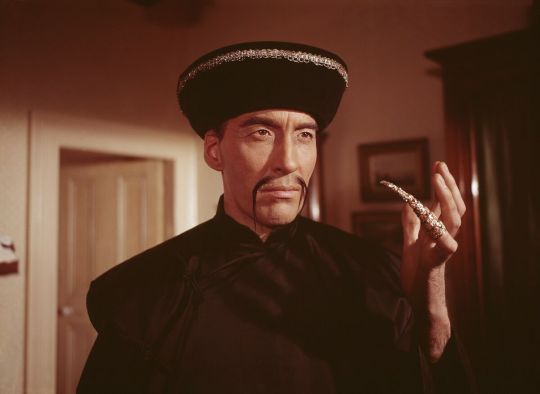
Fu Manchu is a fictional character created by Arthur Ward, a music hall writer and journalist in London in the early 1900s. Writing under the pseudonym Sax Rohmer, Ward had absolutely no knowledge of Chinese culture or Chinese people – but his invention of a Chinese supervillain struck a chord in Victorian Britain and became a smash hit.
Fu Manchu was the original fictional Asian villain, a trope which became embedded in popular culture and Western psyche spawning spin-offs, spoofs, pop songs, video games and even consumer goods. But how damaging is Fu Manchu and how much can he tell us about modern Asian racism?
Ward wrote Fu Manchu as the personification of the so-called Yellow Peril threat: exotic, alien and inhuman, a mastermind boasting degrees from top universities. Using sinister powers to control minds, he aimed to undermine Western civilisation.
"This led to the idea that the Chinese were deceiving – they weren't being honest, they weren't revealing who they really are as people. This spawned into stories of Chinese as cheats and liars and deceitful – never giving you the truth, always fabricating."
Seven Lim being labeled as “greedy” “evil” and “manipulative” (of his white co-founder) is rooted in Anti-Asian racism. Whether people admit it or not.
Racism is not always derogatory slurs or white hoods. Racism is also casual micro-aggressions and putting people of color in the metaphorical boxes of harmful stereotypes. Racism is twisting the narrative and shaping it into a vile stereotype straight from the 19th century.
Also, let's not forget that people are happy to jump on Ryan in the similar way for the same reasons.
#watcher#watcher entertainment#steven lim#watchertv#watcher tv#shane madej#ryan#ryan bergara#tw racism
192 notes
·
View notes
Text
The culture of Lakitus in the Mario Universe
Lakitus are a species of Koopa that are often seen riding around in clouds with faces, throwing items like Spiny Eggs, Piranha Pods, Hammers or Coins at the people below them and using fishing rods to hold or catch all sorts of things. Many Lakitus work as Bowser's Minions, though we've also seen Lakitu reporters, such as the Lakitu Bros. in Super Mario 64, and the referee Lakitu who runs the Mario Kart tournaments and various other Mario sports events.


While most Koopas are ruled directly by Bowser, the Lakitus have their own ruler, King Lakitu, implying they may be more distant culturally from the others. While King Lakitu and his people clearly serve Bowser in modern day, this may have been an alliance that formed in more recent history.

Throughout various Mario games, the Lakitus are connected to the Chinese-like culture in Mario’s World. In Dragon Driftway from Mario Kart 8, a course with Chinese-style architecture, murals of Lakitus practicing Kung Fu can be seen on the interior.
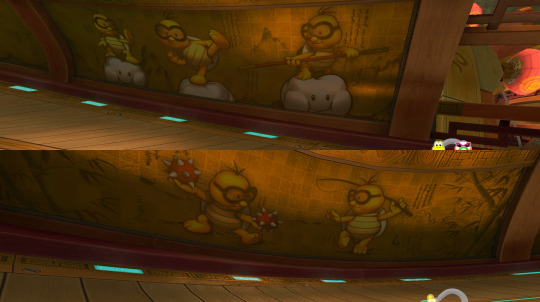

Lakitu’s name written in Chinese characters ("朱盖木") can be seen on lanterns, signs and murals in Dragon Driftway as well as Dragon Palace, where Koopa Troopas can be seen practicing Kung Fu. Lakitu emblems (depicting a Lakitu's Cloud) and statues of Lakitus practicing Kung Fu are both featured prominently in both Dragon Driftway and Dragon Palace.
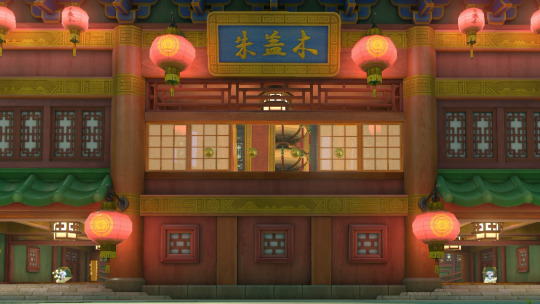


A poster for a movie called “Kung Fu Lakitu” with the subtitle “Dragon Driftway The Movie” can also be seen in GBA Ribbon Road.
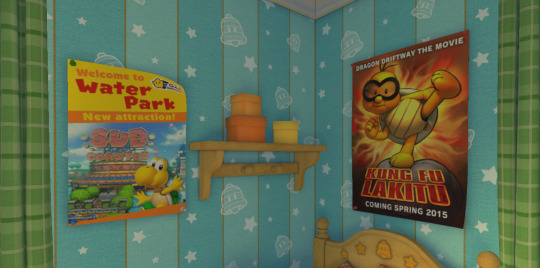
Dragon Driftway appears to have been built in the image of an ancestor of Gobblegut, from Super Mario Galaxy 2, which had four limbs. Gold and silver statues resembling a version of this this Gobblegut ancestor, with a shorter body and "whiskers" resembling those on Draggadon, can be found in the courtyard of Dragon Palace.
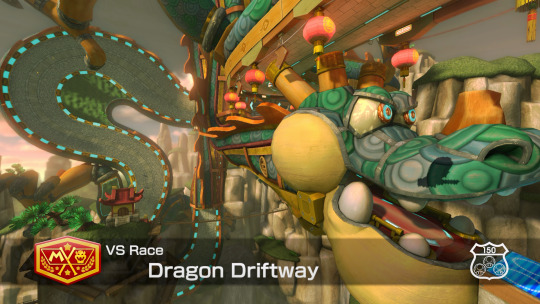

This civilisation may also have built Pagoda Peak, which features Chinese-like architecture and a large green dragon structure with orange horns, very similar to Gobblegut. Pagoda Peak is said to be 4000 years old and is inhabited by Kung Fu Koopas and the Koopa Master. Perhaps the Koopa Troopas seen training in Dragon Palace will go on to become Kung Fu Koopas.


Glitzville from Paper Mario: The Thousand-Year Door is an “exotic” floating city with Chinese-style architecture, presumably modelled after a different region.
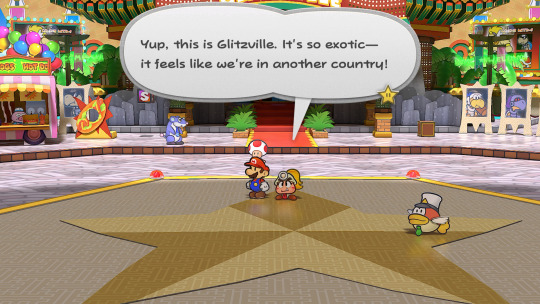

The city is named “Oolong Town” (ウーロン街) in Japanese after Chinese oolong tea. Glitzville is inhabited by many Lakitus, with both guests and local reporters being members of the Lakitu species.
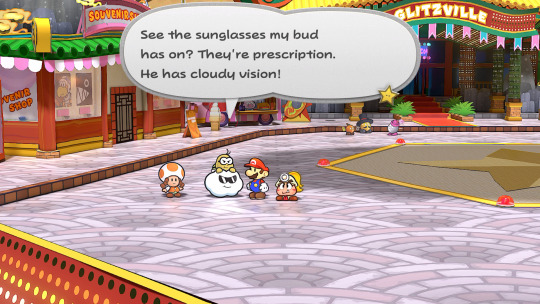
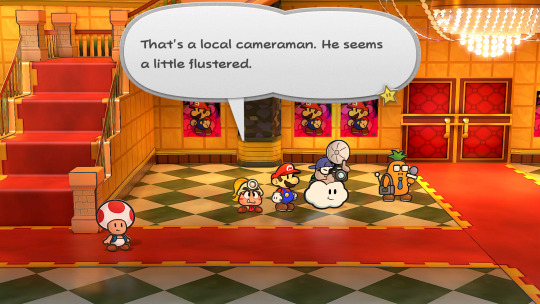
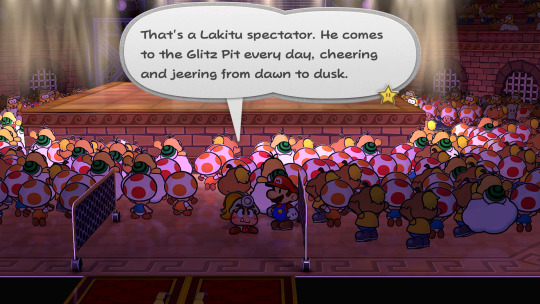
At least a quarter of the Glitz Pit audience is comprised of Lakitus. Perhaps the sky-high location and cultural theming make it a popular draw for Lakitus in the region.

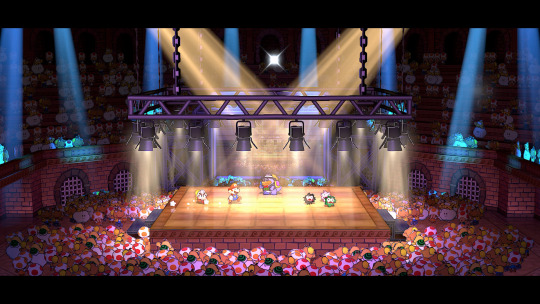
In Super Mario Land, the bosses faced in the Birabuto Kingdom, Muda Kingdom and Easton Kingdom are depicted as the leaders of a specific faction of enemies faced earlier in their respective kingdoms.

The boss of the Chai Kingdom, Biokinton, initially appears to be an exception to this, not bearing a resemblance to any enemies faced in the Chai Kingdom. Biokinton is described as shy and said to be hiding in a cloud which resembles a Lakitu’s Cloud. Rocketons are airplanes piloted by "soldier guards" faced by Mario immediately before Biokinton.

These guards strongly resemble Lakitus with their yellow skin, goggles and short, round noses. They may have a connection to Biokinton given their close proximity and matching name endings in both English and Japanese. “Biokinton” (パオキントン), “Rocketon” (ロケトン).
Perhaps Dragon Driftway, Dragon Palace and Pagoda Peak are actually in the Chai Kingdom, and with the alliance between King Lakitu's and Bowser's families centuries ago, Koopa Troopas began training in Kung Fu and Lakitus began serving in the Koopa Kingdom army.
Thank you to Sophie of @cartographers-office for pointing out the resemblance between Lakitus and the Rocketon pilots, this has been a fun one!
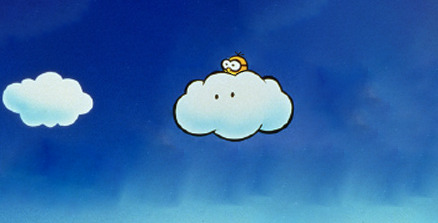
#mario lore#super mario#lakitu#mario kart 8#mario kart 8 deluxe#rocketon#biokinton#super mario land#mario party#mario party 7#super mario galaxy 2
100 notes
·
View notes
Photo

Ancient Chinese Warfare
In ancient China warfare was a means for one region to gain ascendancy over another, for the state to expand and protect its frontiers, and for usurpers to replace an existing dynasty of rulers. With armies consisting of tens of thousands of soldiers in the first millennium BCE and then hundreds of thousands in the first millennium CE, warfare became more technologically advanced and ever more destructive. Chariots gave way to cavalry, bows to crossbows and, eventually, artillery stones to gunpowder bombs. The Chinese intelligentsia may have frowned upon warfare and those who engaged in it and there were notable periods of relative peace but, as in most other ancient societies, for ordinary people it was difficult to escape the insatiable demands of war: either fight or die, be conscripted or enslaved, win somebody else's possessions or lose all of one's own.
Attitudes to Warfare
The Chinese bronze age saw a great deal of military competition between city-rulers eager to grab the riches of their neighbours, and there is no doubt that success in this endeavour legitimised reigns and increased the welfare of the victors and their people. Those who did not fight had their possessions taken, their dwellings destroyed and were usually either enslaved or killed. Indeed, much of China's history thereafter involves wars between one state or another but it is also true that warfare was perhaps a little less glorified in ancient China than it was in other ancient societies.
The absence of a glorification of war in China was largely due to the Confucian philosophy and its accompanying literature which stressed the importance of other matters of civil life. Military treatises were written but, otherwise, stirring tales of derring-do in battle and martial themes, in general, are all rarer in Chinese mythology, literature and art than in contemporary western cultures, for example. Even such famous works as Sun-Tzu's The Art of War (5th century BCE) warned that, "No country has ever profited from protracted warfare” (Sawyer, 2007, 159). Generals and ambitious officers studied and memorised the literature on how to win at war but starting from the very top with the emperor, warfare was very often a policy of last resort. The Han Dynasty (206 BCE - 220 CE) was notable for its expansion, as were some Tang Dynasty emperors (618-907 CE) but, in the main, a strategy of paying off neighbours with vast tributes of silver and silk, along with a parallel exportation of “civilising” culture was seen as the best way to defend imperial China's borders. Then, if war ultimately proved unavoidable, it was better to recruit foreign troops to get on with it.
Joining the intellectuals with their disapproval of warfare were also the bureaucrats who had no time for uncultured military men. No doubt, too, the vast majority of the Chinese peasantry were never that keen on war either for it was they who had to endure conscription, heavy taxes in kind to pay for costly campaigns, and have their farms invaded and plundered.
With the emperors, the landed gentry, intellectuals and farmers all well-aware of what they could lose in war, it was, then, somewhat disappointing for them all that China, in any case, had just as many conflicts as anywhere else in the world in certain periods. One cannot ignore the common presence of fortifications in the bronze age, such chaotic centuries as the Autumn and Spring Period (722-481 BCE) with its one hundred plus rival states, the Warring States Period (481-221 BCE) with its incredible 358 separate conflicts or the fall of the Han when war was once again incessant between rival Chinese states. Northern steppe tribes were also constantly prodding and poking at China's borders and emperors were not averse to the odd foreign folly such as attacking ancient Korea.
Continue reading...
60 notes
·
View notes
Text
[莲花楼 Meta] Di Feisheng and the Three Kings
While looking through the cast list and end credits, I noticed that there had been actors cast as 炎帝白王 Yandi Bai Wang and 四象青尊 Sixiang Qingzun even though we don't get to see them in the final cut. Reading the original script, they appear in a deleted scene (unsure if it was actually filmed) in Episode 05, as a flashback during this scene with the robe in Jiao Liqiao's rooms.

It's explained in the script as Di Feisheng's old Alliance leader ceremonial robe, but in the final cut of the show, it seems to be implied as wedding robes Jiao Liqiao prepared for Di Feisheng.
Scene in original script:

FLASHBACK: Ten years ago, at the headquarters of the Jinyuan Alliance. DI FEISHENG is wearing that luxurious robe, sitting around drinking with the THREE KINGS. The TWELVE PHOENIXES are standing guard at one side. YANDI BAI WANG looks over at the TWELVE PHOENIXES and laughs.
YANDI BAI WANG: Each of our twelve beautiful protectors has her own charms, but we have never seen our Zunshang show any interest in any of them. Could it be… that Zunshang already has someone in his heart?
SIXIANG QINGZUN (shaking his head): Romantic entanglements and ruling the world are not of interest to him. Our Zunshang is only obsessed with martial arts, and all he wants is to be number one in the martial world.
DI FEISHENG (raising his cup proudly): To have a worthy opponent to discuss martial practice and duel for life and death for a hundred battles without getting weary of it, that is the only life I wish for!
YANDI BAI WANG (realisation dawning): If so, the lady you marry must be the most trustworthy, so that she can handle the affairs of the Alliance wisely while Zunshang concentrates on his pursuit of martial arts.
DI FEISHENG (laughing in surprise): That would be ideal!
YANDI BAI WANG (laughingly): I wonder which lady will have the honour!
The TWELVE PHOENIXES continue to stand guard but cannot hide their reaction to the teasing. The THREE KINGS raise their cups and laugh, and from where she is hiding in a distance, JIAO LIQIAO shoots a venomous look at the other women.
END FLASHBACK.
--
This scene is a parallel to Li Xiangyi's 18th birthday celebration, where the Sigu Sect members were urging Li Xiangyi to formalise his engagement to Qiao Wanmian. (Di Feisheng would have been around the same age as well.)

--
Also an interesting point about the titles that Three Kings picked for themselves. Assuming that they were around the same age as Di Feisheng (perhaps with Sixiang Qingzun being the oldest since he was already married and might have been around the age of the other three Nanyin descendants), then their titles might seem rather overblown for a bunch of teenagers/young men in their early 20s lol.
There's however a connection between their titles and the Four Auspicious Beasts (四象) in Chinese mythology; in fact, it's even in one of their titles! (Yes, I know it's translated by iqiyi as Four-faced but I disagree with that translation and I'll get to that.)
1. 四象青尊 Sixiang Qingzun As mentioned, 四象 or Four Aspects/Images is another name for the Four Auspicious Beasts, and "青尊" (Azure Lord) is another name for the Azure Dragon 青龙 of the East. So his title actually translates more accurately to "Lord Azure Dragon of the Four Aspects". I'm pretty sure I'm right because his wife, 两仪仙子 Liangyi Xianzi, has a related name. In 《易经 I Ching》, there is a phrase "两仪生四象" (the two modes – yin and yang – results in the formation of the Four Aspects). And it just happens that she practices a skill that allows her to change her gender!
2. 炎帝白王 Yandi Bai Wang "炎帝 Yandi" is an honorific for the leader or king of a civilisation that dates back to the Neolithic age. Another civilisation from a similar era used "黄帝 huang di" (yellow emperor), and that's why Chinese also call ourselves 炎黄子孙, because we can trace our ancestry back to these two civilisations. So his title translates more accurately to "The Flame Emperor, the White King/Prince". One of the Four Auspicious Beasts is the White Tiger of the West, so it is possible that his title refers to that.
3. 阎王寻命 Yan Wang Xunming "阎王 Yan Wang" is a transcription of the Sanskrit name Yama Raja or King Yama, who is the Chinese god of death and ruler of the Ten Courts of the Underworld. 寻命 is a little more tricky to translate but I think in this context it means to find your fate/destiny and face the inevitable outcome. So his title translates to "King Yama Seeking Fate". Assuming he also represents one of the Four Auspicious Beasts, then he is likely to be the 玄武 Xuanwu of the North (literally "dark/mysterious warrior", usually depicted as a black tortoise intertwined with a snake).
But it's supposed to be four beasts, so who's the fourth? The obvious candidate seems to be Di Feisheng as 朱雀 Vermillion Bird of the South — his official Alliance leader robes are red. Perhaps the Three Kings asked him to pick a fancy title to match theirs, but Mr "Dao is a Dao" refused to participate XD Maybe it's Wuyan, who does have some red in his clothes, which would then make Di Feisheng 黄龙 Yellow Dragon or the symbol of the emperor, which doesn't really match imo.
(As an interesting aside, the original novel 吉祥纹莲花楼 Auspicious Pattern Lotus House is published as four volumes corresponding with the Four Auspicious Beasts.)
#mysterious lotus casebook#di feisheng#three kings of jinyuan alliance#mysterious lotus casebook meta#dihua parallels#LM's translations#long post
89 notes
·
View notes
Note
are there certain visual themes or imagery you yourself particularly associate with yao as an artist or writer? i'm trying to visualize the nations better...
hmmm, interesting question. i like incorporating nature imagery into the hetalias, especially old nations like yao. there's something mythical and compelling about the sense of age and vastness that evokes. these are some (non-exhaustive) thoughts i've had:
a. i always associate yao with rivers and water; the Yellow River in particular, which is often seen as the "cradle" of Chinese civilisation (but of course, there's also the Yangtze, and the Pearl River too). rivers are life-giving but also untameable, powerful and dangerous—the Yellow River's fertile silt birthed agriculture and civilisation, but its destructive floods have claimed uncounted lives over the millennia of Chinese history. and...that's kind of how yao is, as a nation and an empire, towards others of their kind. the source of cultural and artistic innovations, but also death. water can be fluid, life-giving and nurturing, but also as treacherous as a torrential flood sweeping everything away, no?
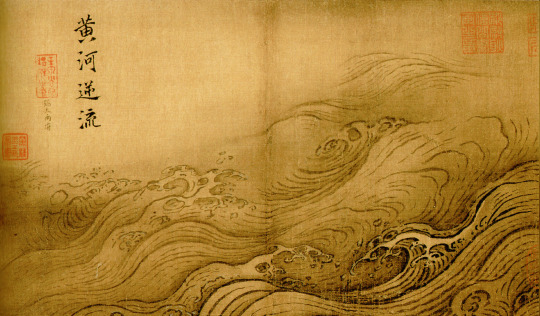
like the Yellow River's relationship with humanity, yao's impact on world history feels to me like this duality of life and death; peace and warfare; mentor, empire, conqueror... it's like, yao's been a teacher to many others but...i don't think their predominant image of him is as a warm and nurturing figure. maybe more so with his own people, but less so with other nations. being the old warlord he is, he'd say certain things very matter-of-factly (especially to yong-soo and kiku), about how power is the only language their kind universally understands, or about history being written by the victors (when we consider how the only surviving written sources about certain periods of asian history are only chinese ones...), inasmuch he'd talk about the importance of confucian virtue, integrity and humility on other occasions.
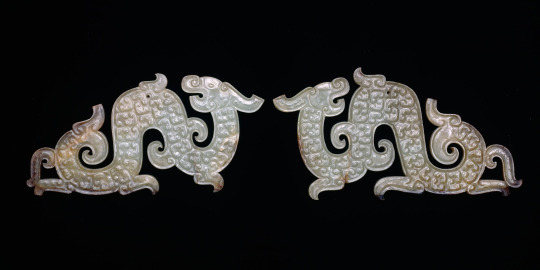
b. for obvious reasons; dragons—they and rivers both have that overlapping association of being serpentine, powerful and untameable. in contrast to how european dragons often took on villainous roles and were harbingers of disaster, it's important to note chinese dragons usually have far more positive cultural connotations. they symbolise prosperity, fortune and are guardians; often associated with power over water (so again; Yao and rivers and water.) many dragons are associated with a particular river or sea. they're also believed to have powers over the weather and were often prayed to. after all, the capriciousness of the rains ruled people's lives so much through natural disasters or made a difference between a bountiful harvest and a famine. so, i think at various points in history his people might also have understood him as a literal dragon (spirit/deity) walking around in a human guise. dragons are also a visual staple of chinese culture, from statues to jewellery. at the same time: while they're auspicious symbols—dragons can of course have aggressive and far less benign connotations if we consider how they became symbols of the emperor—and thus chinese imperial power and dominion over others. he evokes majesty, but also dread from that perspective.
c. plum blossoms: much like the sakura in japanese culture, plum blossoms are one beloved motif you'll see showing up in chinese art and literature throughout history. they're elegant and ethereal, also a symbol of both transience and renewal in a way, i'd say—their blossoms wither and die, but they come back each year. there's also that saying about how without a bitter cold, you won't have the sweet fragrance of plum blossoms, because they start blooming in winter. that's...very yao to me. china, as an idea, makes me think of a lot of elegant and refined traditional culture (like poetry or paintings) which plum blossoms recall—but i also think of humbler themes—the simpler idea of someone and something who is enduring, adaptable and resilient. who endures the harshest weather time and time again until spring arrives, the way my (peasant) ancestors probably did, carving their way through all the hardships of chinese history. yao might appear refined in an indulgent, wealthy way when he's dressed in his finest silk hanfu or a smart western suit in the modern day—but if you shake his hand, his palms are always callused and you can just see the weight (and hard-won experience) of centuries in his gaze.

114 notes
·
View notes
Text
"From books to film to theatre, writers have always been inspired by the stories that came before them. As artists, what are we if not the sum of all we’ve seen and absorbed and alchemised into our own voice? The history of oral storytelling is a history of retelling; the art of storytelling is almost always an act of retelling in some way."
—Wen-yi Lee, "The Comfort (and Discomfort) of Retellings"
"BIPOC retellings are often about demanding a place. Otherwise or at the same time they can critique the rosy nostalgia of fairytale worlds (or the usually-fascist leaning that comes with hyper-defence of Classics and Canon and Civilisation). Queer retellings of great love stories are often claims less to the characters and more to that great love in itself. Retellings are often saying: we, too, claim crowns and prophecies, great loves and romantic tragedies. If these stories have been impressed on everyone as the epitome of human storytelling and mythology, then everyone has equal rights to them."
[...]
"At the same time, there is also a power in simply letting ahistoricity exist, and deliberately not acknowledging oppressive structures at all. Regencies without racism; queer-norm historical settings. Sometimes people are just allowed to imagine themselves in nice things. "Whether it’s interrogating or (re)claiming the original, I think these retellings are most powerful when they have something to say—when they step into the ring with a conversation in mind."
[...]
"The swell of Chinese fantasy has made more mainstream both mythological elements as well as direct retellings: Shelley Parker-Chan’s genderbent Ming Emperor in She Who Became the Sun and Xiran Jay Zhao’s mecha-pilot Wu Zetian in Iron Widow; Ann Liang’s A Song To Drown Rivers, a romantic retelling of one of China’s Four Beauties; Sister Snake, Amanda Lee Koe’s modernised take on the Legend of the White Snake’s monstrous snake women; S.L. Huang’s The Water Outlaws, a queer spin on other Chinese classic Water Margin; Sue Lynn Tan and Emily XR Pan’s reimaginings of the legend of Chang’e (Daughter of the Moon Goddess and An Arrow to the Moon, respectively) and Van Hoang and C.B. Lee’s versions of Sun Wukong (Girl Giant and the Monkey King and The Epic Crush of Genie Lo, respectively)... "We’re somewhere. The next step is obviously okay, good, now more. "I think about non-Western retellings that bear the weight of also being tellings, of being the first time these characters and symbols and histories have ever been presented in the Western or English-language literary scene. What retellings are received as comfortable, and which are received as exotic? ...But I can’t nowadays think about books without also thinking of the social and financial factors affecting their writing, publishing, marketing, distribution, and translation. There are ranges everywhere. So it’s retold once. Will it be retold in different languages, in different countries, in all the bookstores? Even after 'Are we able to tell it?' it’s 'Are we able to sell it?'"
20 notes
·
View notes
Text
Chinese influences on European dragons in the early Middle Ages
Yesterday, I read a chapter about the Parisian saint Marcellus from the book “Time, Work & Culture in the Middle Ages” by French historian Jacques Le Goff. In it, he alludes to the hypothesis, that dragon depictions from the Merovingian era have been influenced by Chinese motives that have come to Europe through cultures from the Central Asian steppe.
That certainly makes sense to me, since the Huns have had a presence in Europe up until the 5th century, but I’ve never heard of this hypothesis before. Le Goffs sources are all in French (for example “La Civilisation mérovingienne d'aprés les sépultures, les textes et le laboratoire” by Edmond Salin), which I can’t read, and a quick search in Google Scholar didn’t bring up anything interesting.
Does anybody know if this hypothesis is still considered? The book is from the late seventies, so maybe it’s something that never caught on or has been discredited since then, but I haven’t found anything on that, either.
415 notes
·
View notes
Text
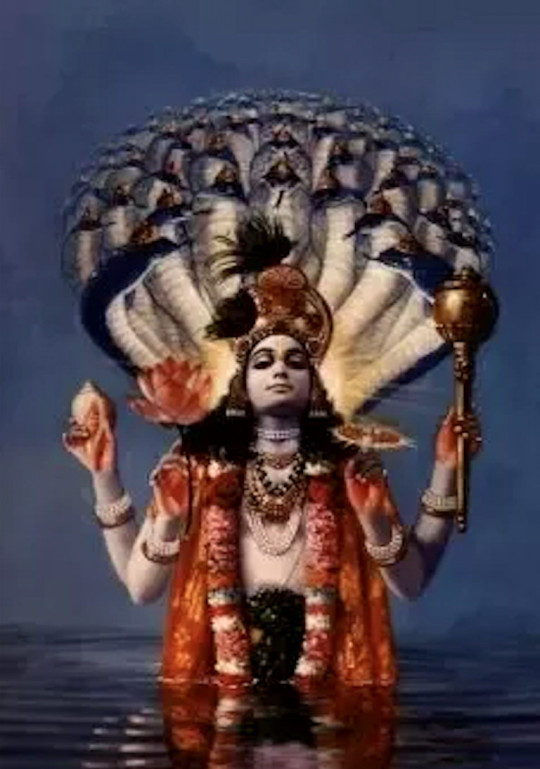
Legends of the humanoids
Reptilian humanoids (8)
Naga – Half-human, half-serpent divinities living in the underworld (Patala)
Name of a Hindu deity. Translated from Chinese as 'dragon', but originally refers to a snake, especially a cobra, as opposed to a Chinese dragon. It is assumed that snake worship already existed in the Indus civilisation. The Aryans gradually accepted the ancient worship of the snake-god and came to regard it as one of the demigods.
In Hindu literature, the Nagas, or snake people, are said to dwell in the subterranean world called Pātāla. Vāsuki and other dragon kings rule that world. At the lowest level of Pātāla dwells the primordial serpent (Shesha) Ananta, whose head supports the weight of the whole world. Nagas often appear in literary works in human form, and the dragon's daughter was described as having a very beautiful appearance.
Nagas are often mentioned in Buddhist scriptures and are one of the Eight Divisions of the Heavenly Dragon. Mahoraga, also belonging to the Eight Divisions, refers to giant serpents, but seems to refer to pythons and other serpents. In Nagaland, near the Myanmar border, there is a tribe called the Naga people, who claim to be descendants of the Naga and have preserved their own customs.
The Naga is worshipped in various Asian religious traditions and rituals dedicated to this supernatural being have been practised throughout South Asia for at least 2,000 years. They are principally depicted in three forms: as entirely human with snakes on the heads and necks, as common serpents, or as half-human, half-snake beings in Hinduism, Buddhism, and Jainism.
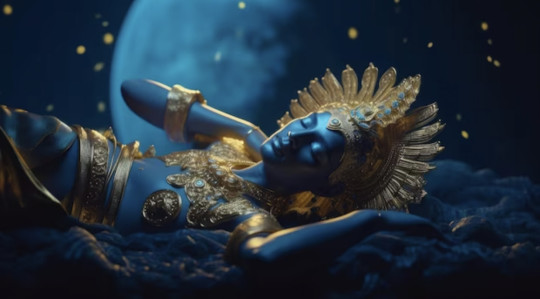
伝説のヒューマノイドたち
ヒト型爬虫類 (8)
ナーガ 〜 冥界 (パーターラ) に住む半人半蛇の神々
ヒンドゥー教の神名。「竜」と漢訳されたが,本来は中国の竜とは異なり,蛇,とくにコブラのことである。蛇神崇拝はすでにインダス文明において存在したと推測される。アーリヤ人は古来より行われた蛇神崇拝をしだいに受け入れ,半神の一つとみなすようになった。
ヒンドゥー教の文献では,ナーガすなわち蛇族は,パーターラと呼ばれる地底界に住むとされる。ヴァースキ (和修吉) その他の竜王がその世界を統治している。パーターラの最下層に原初の蛇 (梵: シェーシャ: 難陀竜王) アナンタが住み,その頭で全世界の重みを支えている。ナーガはしばしば人間の姿で文学作品に登場し,竜の娘は非常に美しい容姿をしているとされた。
ナーガは仏典においてもよく言及され,天竜八部衆の一つである。同じく八部衆に属する摩睺羅伽 (マホーラガ) は大蛇のことであるが,ニシキヘビなどの大蛇を指すようである。ミャンマー国境に近いナガランドには,ナガ族という種族が住んでいて,ナーガの末裔と称し,独自の習俗を維持している。
アジアのさまざまな宗教伝統においてナーガは崇拝され、この超自然的な存在に捧げる儀式は、少なくとも2,000年前から南アジア全域で行われてきた。ヒンドゥー教、仏教、ジャイナ教では、頭と首に蛇を持つ完全な人間、一般的な蛇、あるいは半人半蛇の存在として描かれている。
#naga#hindu gods#snake god#patala#underworld#cobra#snake people#dragon#humanoids#legendary creatures#hybrids#hybrid beasts#cryptids#therianthropy#legend#mythology#folklore#nature#art
98 notes
·
View notes
Text
I don't know if I want to write a massive essay about this, but they missed the whole point with all the characters, especially Ye Wenjie. I'm assuming everyone who said this portrayal is accurate and a raging angry Ye Wenjie is good is because they either never read the book, or non-Chinese, or both. (Or maybe projecting their own views on Maoism). Ye Wenjie received higher education during a time period where it wasn't common for women. She believed in science, she believed in people, but time and time again, the people in her life let her down and never showed any signs of remorse. What I've gathered from the text is that she isn't fuelled by rage, more so she is dead on the inside, she has lost all hope in people. Her decision to reply is not because she wants to destroy, she believes that a civilisation from a higher standpoint could save humans, and this roots in the fact that she is educated. She's not some crazy rage driving women who would ever say "time is a motherfucker", not even a Chinese equivalent.
I'm not sure why the writers decided to write Ye Wenjie and Yang Weining's relationships out of the story...Oh so she is rescued by a white man later on hmm??? (Coincidentally, all the characters driving the plot are also non-Chinese in this). Ye Wenjie marrying Yang Weining and giving birth to Yang Dong gave her a glimpse of light in the life from which she had lost hope. Spending time in Qijiatun also gave her a bit of warmth. When she pushed Yang Weining off the cliff, it marked another significant point, she was calm, cut the rope with no hesitation. She did not care to get herself entangled in romantic affairs. Making her have a child with Evans is laughable. They also dumb down Yang Weining, to the extent that Ye Wenjie had to explain 43+8=51 to him. Mind you, he was a real proper engineer. (Weirdly with all the diversifying, they did not keep a single male Chinese scientist in the main team huh)
Anyways, before I go on a tangent. The writers have fast tracked everything and left out the finer text about the characters in the book. I'm not sure if they missed the point or that nowadays the audience are ruined by fast media, something like the tencent version are simply too slow for the people in the west. Any of my moots and followers who watch cdramas will know that the real good stuff is all in the build-up. It's all the little text that adds up to a fleshed out character. If the culture difference is too much for Netflix, leading them to change all the characters and most of the plot, why not just buy a western ip. There's plenty of good western sci-fi ips.
I can't help but think they want to do this because they wanted to film the scene where Ye Zhetai is beaten to death. Have an excuse to turn Ye Wenjie an angry woman. We all know why. If they really cared about showing a true China during that time, they would have spend some care with the Red Coast details as mentioned above (we did not have screens in 1960s that display Chinese text!!! And definitely no simplified Chinese characters on computers!!!!). Instead of having her snog Bai Mulin off - unrealistic since people were a lot more conserved back then, they would not have done this and it's ooc for Ye Wenjie. Falling in love with Evans - a real blasphemy. I guess the 3 Body Problem here means 3 bodies pounding at each other. Jin-Raj-Will also seem to have their own 3 body problem going on too.
(One last tangent) Ye Wenjie and Yang Dong(Vera) as scientists not believing in god but having monks at her funeral ??????????? Not even a typical normal Chinese funeral will have monks. The stereotype enforcing is real.
#okay i did say im not writing a massive essay in sentence 1 but i got carried away#3 body problem#three body#also changing the game to a mongol background - as if it isnt obv enough what they are trying to do#i cant help but to think that this adaption being bad is what they intended#typical viewer will not care to read the original they'll pass this as bad chinese media and leave a bad impression on china overall
100 notes
·
View notes
Text
The Swords
So I was watching, as you do, some videos by some very charming and passionate martials arts practitioners comparing and contrasting various designs of sword and their usage. And I remembered that I had vaguely, perhaps subconsciously, noticed something strange about the magical swords used in this show.
The first one we see is the Hellfire sword which Dongfang Qingcang materialises as he calls Shangque.

It's straight, with no curve to the blade at all, and both edges appear to be sharp. It's basically cross-shaped, with a large, decorated cross-guard extending parallel with both edges. And it has a fairly large roundish pommel, by which he holds it:

I think I semi-consciously noticed that this looks a lot more like a European longsword, except that it's not all that long. Chinese swords are usually curved, even if only slightly, are usually sharp on one side only, and usually have disc-shaped handguards. [Edit! see reblogs for information on jians, which are straight and double-edged but with tiny crossguards] They sometimes have pommels, but the kind you see in the Wuxia genre generally doesn't.
So I thought, is this one of the subtler ways in which they're setting out to make Dongfang Qingcang and the Moon Tribe seem a little bit foreign and therefore barbarous, "not-Han-coded", as someone on Discord put it?
But then I checked the other swords, and that's not it.
Changheng's is a bit ambiguous. It has a pronounced cross-guard, less elaborate but more fantastical - it seems to be thinking about morphing into a 16th-century European basket hilt, as that downturned curve wouldn't work to catch your opponent's blade, but it isn't quite there yet:

The blade also looks very straight, and we don't see the prop without the CGI for long enough to tell whether it's meant to be sharp on both edges. It might be more of a sabre, a design that pops up in martial arts traditions everywhere.
The third sword we see is Lady Chidi's battle sword, which is the same basic design as Dongfang Qingcang's:

As you can see in the closeup, it's cross-shaped, double-edged, straight, and symmetrical, with a pronounced pommel, a long hilt for two hands, and a large cross-guard parallel to the edges.
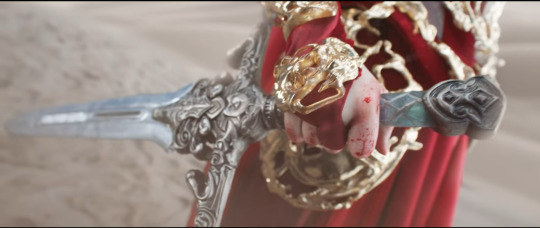
This shape is important, because scale is an optional setting for powerful immortal beings, and she will soon turn it into this mountain, with the cross-guard becoming a very convenient platform for conversation and sunbathing:
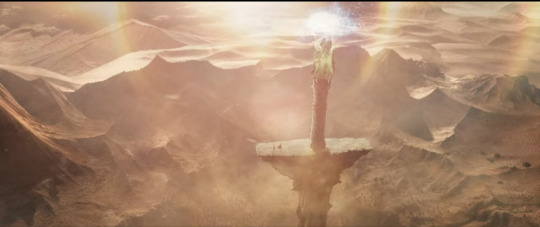
The other plot-relevant sword, in Episode 31, is the same cross-shape, with a really big cross-guard and a fairly pronounced pommel.

However! Intriguingly, to spar with Ronghao in the illusion-forest in Episode 32, Chidi uses a very simple blade, straight, but with neither cross-guard nor pommel, like a civilised Chinese lady:
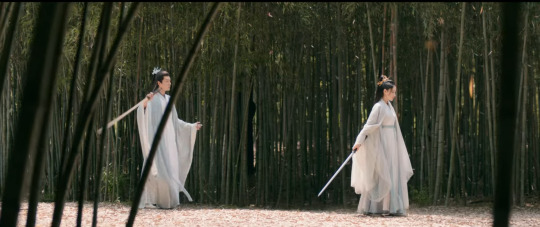
It might be double-edged or single-edged, I can't tell, but it has virtually no hand guard at all, not even a round one like a katana:
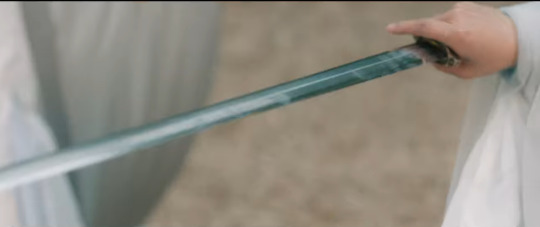
But when in a later scene Ronghao confesses, it is her own, true sword she drops, as a sign that things are getting simultaneously more magic and more real:
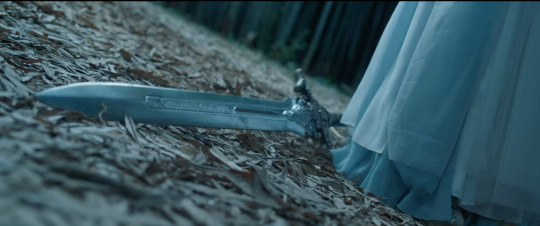
In Ep34, she uses it to kill some unfortunate pikemen:
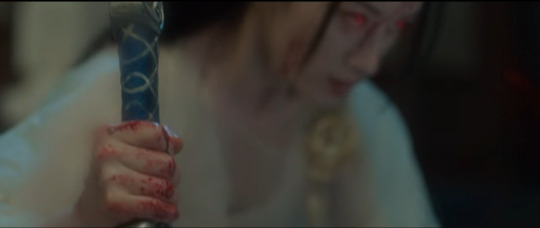
Meanwhile, back in Ep 16, Yannu's sword was the same plot-relevant shape, like Dongfang Qingcang's, and she holds it like a medieval warrior saint looking down from a Gothic arch:
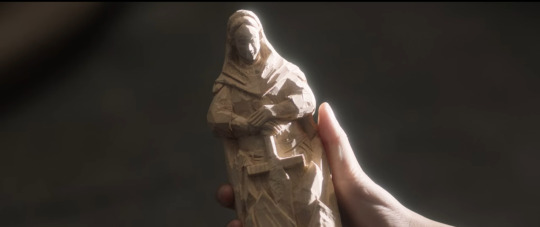
He held it the same way when Shangque greeted him in Episode 2.

Danyin's sword, when she manifests it, is in a rather modest and perhaps youthful style. Still straight and symmetrical, but with a very small, sharply hooked cross-guard:
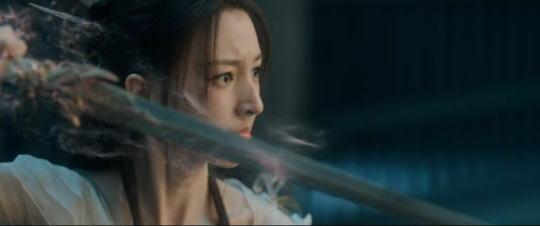
When Dieyi's whip-chain-flail-thing turns into a sword, it's even more European - it looks very like a rapier with a basket hilt! Kind of appropriate to her general look, actually, and her street-fighting personality.

When she changes stance we see this bonkers wiggly blade, which looks still rapier-ish (long, pointed, thrust more than cut), only insane. She doesn't use it like a rapier, though.

Ronghao's sword for killing is a curious design, still straight and with a pommel, but this curious sort of vestigial, bulbous thing that isn't really a guard of any kind. I don't know what's going on with this but the shape is a little bit like Theoden's sword in Return of the King. Not quite.
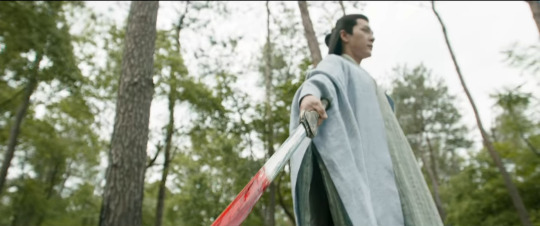
However, when Chidi eventually attacks him, they both use their simple sparring blades again:

Anyway! I was surprised to discover how nearly all of the swords used in this particular show visually followed styles I am familiar with both from western drama and from western historical collections, and none of them, except the ones in that last shot, looked at all like the most common styles of sword you see in Chinese dramas.
Obviously the weapons function exactly like the costumes in that they're primarily artistic visual references to various moods and ideas, rather than functional objects, but I think that makes this choice even more interesting. I don't know how usual it is for this genre, or what it means.
I haven't found where, if at all, we see Xunfeng or Shanque use a sword, and it's long past my bedtime so I'm stopping there.
#can lan jue#lbfad costumes#costumes and weapons meta#lbfad#love between fairy and devil#dongfang qingcang#rong hao#this is actually weird in a fascinating way#I don't think we ever see shangque use a sword
81 notes
·
View notes
Note
I was making tiny clay cats earlier and had a great idea for an ask, but then I got busy and forgot
I think it was something about fashion with the mass effect species
Electronically sending you a fictional tiny clay cat statue
Thank for the tiny clay cat, I'll put it on the virtual table that I keep in this blog at all times, which is a real table that happened to have a unique eco-friendly design, from an eccentric manufacturer, and definitely not just two logs I lugged from the woods.
🕔
🌱🐈 🪟🏙
🪵🪵 🧺 🩲 🪤 🐁
I hope my virtual son 🧒 (common) ×1 doesn't knock it off with his virtual ball ⚽️ (common) ×1 because I won't financially recover from the purchase of the virtual gold 🪙 (rare) ×99 I'd need to glue the pieces of the broken clay cat back together in order to teach him about Kintsugi, the value of history and taking pride in the scars it leaves on ones body.
But yes, Mass Effect alien species fashion.
I mentioned before that the asari would definitely be into human fashion since we share a similar physical build.
They tend to mix up the centuries, however, wearing Edwardian era garments one day, and then full-on ancient Rome with draped tunics the next one.
To us, that seems silly because it's our history. These fashion designs are centuries old, and our first ever impressions on them were in textbooks or some other non-fashionable place. You wouldn't have a woollen toga at a strip mall where tweens naturally went with their overbearing parents to develop a sense of style.
But to the asari, all of these clothes are brand new! Just in! The latest fashion trends! From the perspective of their timeline, their society started integrating skinny jeans at the same time as robe à la française.
And the fact they live for 1000 years, the entirety of human recorded history is just two asari generations—would help them see our ancient fashion as more of "last Wednesday's"
Although many human cultures do keep their tradition clothes alive, like the hanfu being used in Chinese festives, or the Arab thawb still worn as in commonplace same as it was in 600 AD.... because what other garment is more suitable for desert climates?
Okay back to aliens, my fashion hyperfixation is showing
The asari are easy peasy, it's like two sister civilisations deciding to share their wardrobes and doubling the amount of clothes they retroactively have access to now.
You see many humans on the Citadel adapt to asari fashion, and as the game progresses, you notice asari fashion start getting influenced by predominantly human-fashion traits. Take Ryder's clothes in Andromeda for example.
The Alliance uniforms must seem ancient to the new humans with their cross-species influenced fashion trends, and I do mean ancient.
They probably view them (alongside our current modern hot-trendy fashion), like how me and you view the Victorian era fashion through a thick lens of rose-tinted glass. I wear corsets over flowy blouses, corsets, the thing that used to be considered underwear.
It's just very socially accessible now. Would someone someday wear a 2000's cheetah print thong over their military uniform in the alliance and call it fashion? Who's to say.
You see those modern two-piece suits with neon vibrant colours? The ones with precise cuts, invisible stiches, and all the pieces—down to the jacket buttons—are made from the same exact material and colour?
Someone is gonna dig that up in the year of Mass Effect and call it vintage and it's gonna piss me the fuck off, the trajectory of the earth will be altered from the massive rolls I'll be doing in my grave.
For the rest of the species, I don't see them adapting our garments due to anatomy incompatibility.
But fashion is the keyword here, because it is so much more than just clothes.
None of the asari have eyebrows, they don't have the genes for hair, therefore no eyebrows or anything.
Except, Liara, who has drawn-on (or perm tat) eyebrows.
Which is a VERY human feature, eyebrows might as well be the trademark of humanity. What do you do to an animal in animation to humanise it and make it seem intelligent?
You add eyebrows.
Liara, this rando asari scientist, for some reason, is elbow-deep into human makeup. Literally, no other asari has eyebrows or showed care for human makeup besides her.
We humans can't see our own "invisible" stripes, our faces are usually a blank canvas, which is why makeup is so fun, pretty, and whimsical. It's the same reason you'd add flowers to your hair or draw at the empty corner of the page.
Asari have their own seemingly natural face markings (unless those are drawn too) and putting makeup on top of them might seem distasteful or even tacky. Like drawing over someone's complete drawing.
But you know which species LOVES adding lines to their face? None other than space birbs themselves, the humble turians.
Humans like sunsets, birds like shiny things, and turians love glitter.
Of course, there are zero evidence of that ingame because they wanted the turians to have a metal, baddass, slightly scary aesthetic, and that's fair.
But if we're being realistic, it's just a matter of time before a turian decides to incorporate glitter into their clan face paint. It's a natural instinct for them to be the bird with the shinest, puffest, most colourful coat of feathers in the room.
Turians would love human makeup, wasn't it for the fact it's deadly toxic to them. Thanks, dextro. I mean, not like that ever stopped humans before. Remember when lipstick used to contain lead and mercury? Good time, good times.
But actually, now thinking about it, would those things be poisonous to them? Lead and mercury? I mean, they're already radioactive with a shit ton of copper in their bloodstream. Their body literally grows metal on their faces... and turian seminal fluid is poisonous to humans, meaning...
They might be able to use mineral based makeup! Which is so fucking deadly to humans, but probably fine for turians.
Although the human skin is spongey, the creamy make-up sticks to the top of it like icing on a cake. But it might not latch onto rough metal, aka turian plates.
It's also made with so many oils in mind because humans are actually very slimy, we just never notice it because our pores are so small and the thin layer of oil is hardly noticeable.
It's why bugs find us disgusting and wash our oill off of them after touching us, too bad they still need our delicious nutritious dead skincells and sweat to slurp up, so they endure it for the sake of food.
But we do, in fact, require being moist 24/7. It's where the "soft" skin feeling comes from, silly, being drenched in oil throughout your whole existence does that sometimes.
And turian metals do not, actually the oils might just bleach their shells if left to oxidise.
No, turian makeup wouldn't work if it was creamy or liquidiy like ours—even with the added lead.
My proposal: Chalk Makeup.
It's dry, it's crumbly, it's easy to remove. You ever drawn with chalk on street concrete? Would probably be the same as applying makeup to a turian.
And it has calcium! Yummy yum! Which the turians probably need a shit ton of, considering that most creatures with some kind of shell do insatiably crave it (see: sanils)
My last nugget of wisdom is that what's considered fashion to the geth/ai/synthetics in general isn't that far off from high-end, very personalised custom gaming pcs. Be it the pastel and white hardshells or the neons and glowing cooling liquids.
Hipster geth prefer the fruitger ero early 2010's aesthetic, enjoy that mental image for a while.
19 notes
·
View notes